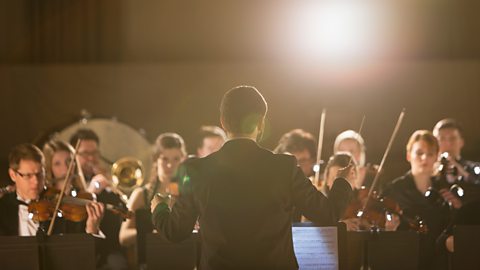Classical

The classical music era is usually seen as the years between approximately 1750 and 1820. Famous composers from the classical period include:
- Joseph Haydn
- Wolfgang Amadeus Mozart
Classical music is recognised for:
- beautiful melodies
- homophonicHaving one line of melody that is played by all instruments at the same time. Literally 'sounding together'. accompaniments
It introduced the Alberti bassA type of arpeggio, or 'broken' chord, in which the notes of the chord are played in the order lowest, highest, middle, highest., a chordal pattern where the notes of the chord are broken up. It also continued to use ornamentation in melodies for decoration. The opening of Mozarts 'Piano Sonata, K545' is a well known example of alberti bass. The audio clip below also features trills as ornament.
'Piano Sonata, K545' by Mozart performed by Philippe Entremont
Instruments
Classical composers built their orchestras on the foundations of baroque music but they were bigger in size. They were based on:
- strings - violin, viola, cello, double bass, and sometimes guitar
- woodwind - recorder or wooden flute, oboe, bassoon and clarinet
- brass - trumpet, horns (with valves by the end of the period)
- percussion - timpani (kettledrums) and sometimes triangle, hand cymbals and bass drum
- key - fortepiano
Classical orchestras were bigger in size and as instrument building improved so did the range of dynamics in the performance. The harpsichord was replaced with the fortepiano, the precursor to today’s modern piano.
Types of classical music
Instrumental music became very important in this period.
Composers created the symphonyA large piece of orchestral music with four movements. Each movement has a different tempo and mood. to be played by an orchestra. A symphony is a large piece of work with four movements. Each movement has a different tempoThe speed or pace of performance in speech, dance or music. and mood.
In the video below, the Royal Scottish National Orchestra play extracts from Shostakovich’s 6th Symphony.
The piece was written in 1939 and unusually only has three movements – symphonies normally have 4 movements – and is about 30 minutes long. In the clip the orchestra plays from the first movement (which is the main movement and nearly 20 minutes long) and the final movement.
The Royal Scottish National Orchestra play extracts from Shostakovich’s 6th Symphony.
The concerto, a work for a solo instrument accompanied by an orchestra, was developed further, with composers added cadenzaA ornamental passage that is played by a soloist.
A cadenza consists of themes and melodies from the concerto arranged to display the technical virtuosity of the soloist. Some performers were so confident in their musical talent that they would improvise their cadenza rather than play a piece they had practiced.
In the video below, the Royal Scottish National Orchestra and pianist Boris Giltburg perform an excerpt from Sergei Rachmaninoff’s Piano Concerto No. 3. This is an example of a concerto - a soloist accompanied by an orchestra.
The Royal Scottish National Orchestra and pianist Boris Giltburg perform Rachmaninoff.
It was also common during this period for musicians to play chamber music, where a group of musicians could get together to play in a smaller venue, without the need for a full orchestra.
Classical composers wrote many string quartets, with Mozart's 'Eine Kleine Nachtmusik' a good example.
'Eine Kleine Nachtmusik' by Mozart performed by Academy of St. Martin-in-the-Field and Sir Neville Marriner
Structure
Structure was very important during this period. Composers liked their music to be balanced for the listener and so a number of forms evolved. These included:
- Binary form (AB) - where the music has two clear sections.
- Ternary form (ABA) - where the music has two sections then returns to the first section again
- Rondo form (ABACA) - where the music has one section which keeps returning and is sandwiched between lots of different sections
Another addition to musical structure in the classical period was the coda.
A coda is the final section in a piece of music, often 8 or 16 bars long.
Some composers would use a loud coda that was full of repetition. This would create a dramatic finish that made it clear to the listener that the piece was about to end.
The First Movement of Beethovens 'Symphony No. 3 in B Minor' is an example of a coda where the dynamics build to a powerful and definite ending.
'Symphony No. 3 in B Minor' by Ludwig van Beethoven Coda from the First Movement
Some composers would use a rallentandoA gradual slowing down or decrease in tempo. in a coda. This would slow the music down to show it ending. A diminuendoA gradual decrease in volume. where the music gets quieter and quieter until it cannot be heard any more could also be used. This is similar to the use of a fade out in modern music.
In this video, Daniel Ciobanu plays Mozart's 'Rondo alla Turca'. You will hear some of the features mentioned above, such as rondo form, homophonic texture and coda.
Daniel Ciobanu plays Motzart's 'Rondo alla Turca'